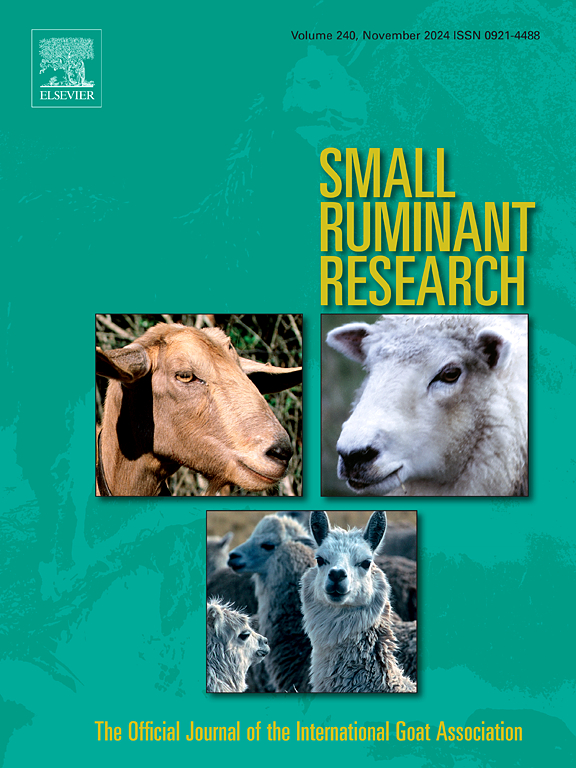求助PDF
{"title":"Evaluating the impact of orange oil and sunn hemp hay on digestibility and anthelmintic efficacy in Texel ewes","authors":"Lorena Carmona-Flores , Marcelo Wallau , Catalina Cabrera , Joao Mauricio Bueno Vendraminid , Diwakar Vyas","doi":"10.1016/j.smallrumres.2024.107296","DOIUrl":null,"url":null,"abstract":"<div><p>Gastrointestinal nematode <em>Haemonchus contortus</em> is a major challenge for small ruminant production systems in the Southeast US. Alternative approaches to nematode control are needed to circumvent parasite resistance to chemical anthelmintic. The study aimed to evaluate the in vivo effects of orange oil (ORG) and sunn hemp hay (SH) supplementation on fecal egg counts, FAMACHA© and body condition score (BCS), hematological parameters, nutrient digestibility, and growth performance in Texel ewes. Forty-eight ewes (∼ 6 months; 31.3 ± 4.1 kg body weight) were orally dosed with 10,000 <em>H. contortus</em> larvae (L3 stage). Experimental pens (N=12; 4 ewes/pen) were blocked by low, medium, and high fecal egg counts. Treatments were arranged in a 2 × 2 factorial model with 2 levels each for SH and ORG. Treatments were: 1) Control: Pen receiving coastal bermudagrass based basal diet; 2) ORG: Pens receiving basal diet with orange essential oil; 3) SH: Pens receiving basal diet replacing 20% coastal bermudagrass hay with SH; 4) SH+ORG: Pens receiving SH with ORG. Experimental duration was 6 weeks including one week for adaptation and 5 weeks for data collection. Orange oil was orally dosed (600 mg/kg of body weight) once during week 1 of data collection. Data were analyzed using PROC GLIMIMIX of SAS with SH, ORG, and blocks as fixed factors while pen was used as random factor in the model. Fecal and blood samples, body weight, BCS, and FAMACHA© scores were collected once weekly. ORG was effective at lowering 37% of Strongylids (<em>including Haemonchus contortus</em>) egg counts in fecal samples while no effects were observed with SH. No treatment difference was observed on dry matter intake, and body weight (BW); while dry matter (DM), neutral detergent fiber (NDF), acid detergent fiber (ADF), and crude protein (CP) digestibility was lower in response to SH supplementation. In conclusion, ORG has anthelmintic potential; however, future studies should explore the mechanism and economic benefit of using ORG for small ruminant producers.</p></div>","PeriodicalId":21758,"journal":{"name":"Small Ruminant Research","volume":"236 ","pages":"Article 107296"},"PeriodicalIF":1.6000,"publicationDate":"2024-05-28","publicationTypes":"Journal Article","fieldsOfStudy":null,"isOpenAccess":false,"openAccessPdf":"","citationCount":"0","resultStr":null,"platform":"Semanticscholar","paperid":null,"PeriodicalName":"Small Ruminant Research","FirstCategoryId":"97","ListUrlMain":"https://www.sciencedirect.com/science/article/pii/S0921448824001020","RegionNum":3,"RegionCategory":"农林科学","ArticlePicture":[],"TitleCN":null,"AbstractTextCN":null,"PMCID":null,"EPubDate":"","PubModel":"","JCR":"Q2","JCRName":"AGRICULTURE, DAIRY & ANIMAL SCIENCE","Score":null,"Total":0}
引用次数: 0
引用
批量引用
Abstract
Gastrointestinal nematode Haemonchus contortus is a major challenge for small ruminant production systems in the Southeast US. Alternative approaches to nematode control are needed to circumvent parasite resistance to chemical anthelmintic. The study aimed to evaluate the in vivo effects of orange oil (ORG) and sunn hemp hay (SH) supplementation on fecal egg counts, FAMACHA© and body condition score (BCS), hematological parameters, nutrient digestibility, and growth performance in Texel ewes. Forty-eight ewes (∼ 6 months; 31.3 ± 4.1 kg body weight) were orally dosed with 10,000 H. contortus larvae (L3 stage). Experimental pens (N=12; 4 ewes/pen) were blocked by low, medium, and high fecal egg counts. Treatments were arranged in a 2 × 2 factorial model with 2 levels each for SH and ORG. Treatments were: 1) Control: Pen receiving coastal bermudagrass based basal diet; 2) ORG: Pens receiving basal diet with orange essential oil; 3) SH: Pens receiving basal diet replacing 20% coastal bermudagrass hay with SH; 4) SH+ORG: Pens receiving SH with ORG. Experimental duration was 6 weeks including one week for adaptation and 5 weeks for data collection. Orange oil was orally dosed (600 mg/kg of body weight) once during week 1 of data collection. Data were analyzed using PROC GLIMIMIX of SAS with SH, ORG, and blocks as fixed factors while pen was used as random factor in the model. Fecal and blood samples, body weight, BCS, and FAMACHA© scores were collected once weekly. ORG was effective at lowering 37% of Strongylids (including Haemonchus contortus ) egg counts in fecal samples while no effects were observed with SH. No treatment difference was observed on dry matter intake, and body weight (BW); while dry matter (DM), neutral detergent fiber (NDF), acid detergent fiber (ADF), and crude protein (CP) digestibility was lower in response to SH supplementation. In conclusion, ORG has anthelmintic potential; however, future studies should explore the mechanism and economic benefit of using ORG for small ruminant producers.
评估橘子油和苘麻干草对德赛尔母羊消化率和抗蠕虫药效的影响
胃肠道线虫柯氏萦线虫是美国东南部小型反刍动物生产系统面临的一大挑战。需要采用其他方法来控制线虫,以避免寄生虫对化学驱虫药产生抗药性。该研究旨在评估补充橘子油(ORG)和苘麻干草(SH)对特克塞尔母羊粪卵计数、FAMACHA© 和体况评分(BCS)、血液学参数、营养消化率和生长性能的体内影响。给 48 只母羊(∼ 6 个月;体重为 31.3 ± 4.1 千克)口服 10,000 颗 H. contortus 幼虫(L3 阶段)。实验围栏(N=12;4 只母羊/围栏)按低、中、高粪便虫卵数划分。处理采用 2 × 2 因子模型,SH 和 ORG 各占 2 个水平。处理为1) 对照组:2)ORG:添加橙精油的基础日粮;3)SH:添加 20% 海岸百慕大草干草的基础日粮;4)SH+ORG:添加 ORG 的基础日粮。实验持续时间为 6 周,包括一周的适应期和 5 周的数据收集期。在数据收集的第 1 周,口服一次橙油(600 毫克/千克体重)。数据分析采用 SAS 的 PROC GLIMIMIX 方法,SH、ORG 和区块为固定因子,笔为随机因子。每周收集一次粪便和血液样本、体重、BCS 和 FAMACHA© 评分。ORG 能有效降低粪便样本中 37% 的斯特龙线虫(包括传染性单胞菌)虫卵数量,而 SH 没有效果。在干物质摄入量和体重(BW)方面未观察到处理差异;而干物质(DM)、中性洗涤纤维(NDF)、酸性洗涤纤维(ADF)和粗蛋白(CP)的消化率则因补充 SH 而降低。总之,ORG 具有抗蠕虫的潜力;然而,未来的研究应探索小反刍动物生产者使用 ORG 的机制和经济效益。
本文章由计算机程序翻译,如有差异,请以英文原文为准。


